|
return
to homepage
return
to updates
VENICE
BIENNALE 2009
by
Miles Mathis
The Venice Biennale just ended
(November 22, 2009), allowing the Muses to return to the Earth
from more artistic planets, and allowing me to reawaken as their
chosen scribe. I have been instructed to use an article in Art
in America as my temporary target
(September, 2009, Marcia E. Ventrocq).
As usual, the
article is not so much to do with art as it is to do with
curators and critics. The central subject of Ms. Ventrocq is
Daniel Birnbaum, the rector of the Stadelschule in Frankfurt and
the chosen organizer for this Biennale. Birnbaum is making his
career as a curator and critic, having already organized the
Moscow Biennial, as well as major shows at the Pompidou in Paris
and the Serpentine in London, and writing reviews for Art
Forum. His ongoing pet project is the
Portikus museum in Frankfurt, which is one of the worldwide
havens of experimental art (read propaganda for art theory). To
understand my counter-critique here, you must understand
Birnbaum's taste from the beginning, so here is a sample of
it.

That
may look to you like some spray cans in a window, but no, it is a
“sculpture” by Rachel Harrison. This is the poster for her
Portikus exhibition entitled “Haycation.” Harrison thinks
some cans in a window is a sculpture, and Birnbaum finds her
artistic, for some reason. That alone should finish off both
Harrison and Birnbaum, but I have been instructed to continue
punching him in the stomach for a few more pages, as catharsis.
Ms. Ventrocq tells us in the second paragraph
that,
Birnbaum's title for the 53rd
Biennale, “Fare Mondi” or “Making Worlds”, likewise stays
aloft in the metaphoric heavens....
We
have already seen his abilities as a curator; we now see hers as
a writer. An old-fashioned editor might have asked her how
“making worlds” is either metaphoric or heavenly. It is a
metaphor for what? Like most art-speech, it is both pedestrian
and foggy. Being opaque is not the same as being poetic. And
“making worlds” is the opposite of heavenly, since it is
explicitly terrestrial.
But both the endless catalog and
Birnbaum's speeches on Youtube make a prolonged Haycation of this
title, as if it were something incredibly deep. Since he has
nothing of substance to tell us, Birnbaum spends many minutes
babbling about this title and its various translations, assuring
us that the exhibition is multicultural and multi-ethnic and
multi-gendered and polymorphously inclusive of every possible
artistic disability. Or, as Ventrocq so ineloquently puts
it,
this show abjures the
temperamental determinism of the dark side for an endorsement of
art as an arena of free and enlightened invention.
Determinism.
What does that word mean in that sentence? Does it mean anything?
Is the dark side either more or less deterministic than the light
side? If so, I, as Jedi Master, was not aware of it. And how can
determinism be temperamental? It can't: those words are just a
fancy and blurry intro into the coming lie, that this show is an
endorsement of any sort of enlightenment. Modern curation and
criticism is entirely and intentionally a barrage of illogic
meant to brutalize your brain into overlooking falsehoods.
The
second paragraph ends with another of these fine
falsehoods:
Birnbaum intends to
validate the creative individual, but the exhibition succeeds
largely on the refinement and wit of his selection and
positioning of works. It is very much the curator who is making
worlds here.
Here we have the subtle
mixing of truth and falsehood, as further confusion. Yes, the
curator is primary, and the critic will admit it; but all else is
topsy-turvy. Birnbaum does not
intend to validate the creative individual, he intends to
validate himself first and the fake artist second. He intends to
validate criticism, curation, and theory at the expense of the
artifact, and the best way to do this is to choose trifling
artifacts by trifling people. This art is so trifling that the
positioning of the works trumps the works themselves. The space
between the art is more artistic than the art.
Isn't it
strange that Ventrocq can admit that the curator is the primary
entity in a show of art, and the readers never blink an eye?
Ventrocq does not find this inverted or perverted, the editors do
not find it inverted or perverted, and the readers and museum
goers do not find it inverted and perverted. We must conclude
that all these persons are also inverted, perverted, and
otherwise useless to art and art history.
The Biennale
statement quotes Birnbaum as saying he will seek to "steer
clear of the hierarchies dictated by commercial interests and
fashion." Come on. That is like Obama saying he will seek to
steer clear of war. Obama was hired by the Department of Defense
and Wall Street, who also own the Nobel Committee, so we can
expect to see him given the Peace Prize for invading the entire
Middle East. Likewise, Birnbaum was hired by the commercial
hierarchies of art, so he cannot steer clear of them. We can
expect to see him feted in the media, always a mouthpiece of
business, while flipping the truth on its ass. Critics and
curators, like politicians, are well-paid liars, and we would all
do well to walk the other way. I am not talking of skepticism.
Skepticism is a weak and outdated cocktail. I am talking of a
prejudicial and well-earned total disbelief. If they tell you it
is day, you know it is night without looking out the window or
checking a clock.
According to Ventrocq, Birnbaum is
supposed to have a “gentlemanly disinclination to engage in
generational pandering and identity politics.” If that were
true, we must think he chose a curious field to go into. It is
like going into the restaurant business and claiming you have “a
gentlemanly disinclination to serve food.” Modern art is
defined by identity politics, so how can a curator have a
disinclination for it? If Birnbaum really had a disinclination
for identity politics, he would be where I am: hanging off the
edge of the artworld by his fingertips.
Ventroqc even
supplies the disproof of her own statement. Two pages later, she
says,
Like the 2007 Biennale of his
predecessor, Robert Storr, Birnbaum's edition embeds some
generally unfamiliar young artists...in a context that honors
their predecessors. Birnbaum's rostrum of elders (John Baldessari
and Yoko Ono, the two winners of the Golden Lion for Lifetime
Achievement...) and dead worthies...seem to skew hipper than
Storr's...
Sounds like generational
pandering to me. Identity politics is also on hand:
Pascale
Marthine Tayou's Human Being,
an elaborately constructed African village, appears to be
slipping into twilight.
Nathalie Djurberg's...Claymation
videos that narrate...raw sexual encounters which can only be
called clerical porn.
Georges Adeagbo's collection of
magazines and assorted objects form Europe and West Africa.
Birnbaum quotes Oyvind Fahlstrom in
his catalog essay, telling us to “Consider art as a way of
expressing a fusion of 'pleasure' and 'insight.'” First of all,
why are those words in single quotes? If we take the quotes away,
is anything lost? No, neither Birnbaum nor Fahlstrom is using the
words as words, so there is no “reason” to use quotes. Beyond
that, the definition is fine, except for one thing. None of the
art in the Biennale confirms it. All the art in the Biennale
contradicts it. But perhaps the quotes were used to indicate
irony? Modern art does not give pleasure, it gives “pleasure.”
You know, with the eyes rolled. As in, Goldman Sachs is doing the
work of “God.” Obama is the candidate of “peace”.
McDonalds chicken sandwich is a “healthy” alternative.
Just
look at the “pleasurable” and “insightful” works chosen
by Birnbaum.
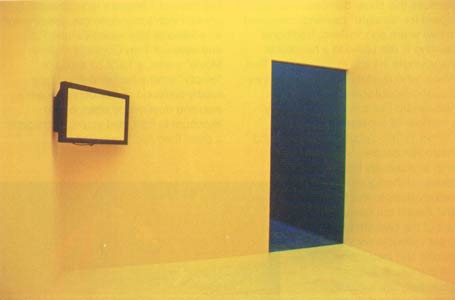 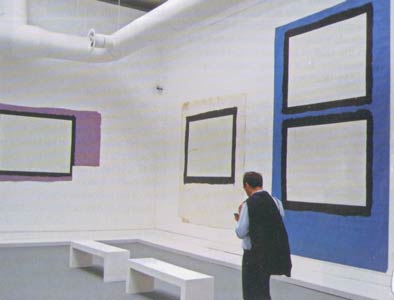 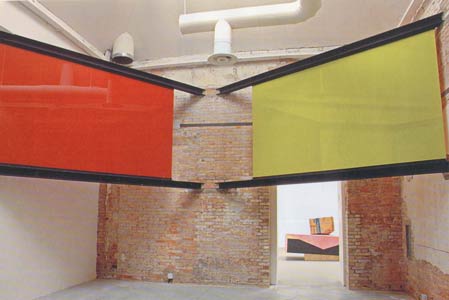
The
first is one of six colored rooms by Cildo Meireles, complete
with colored monitors. The second is by Tony Conrad, and is latex
paint on paper. The third is by Palermo, and is two of four
painted glass panels. In the second and third images, we must
assume the pleasurable and insightful heating ducts are part of
the building: Peter
Schjeldahl would be thrown into an orgy of orgasms by these
serpentine and ejaculatory vents, giving full credit to the
artist for his bliss, but I don't think we can do the
same.
Speaking of which, a search on the web for images of
the 2009 Biennale turns up four different pictures of totally
nude men lounging around or outside the museum.
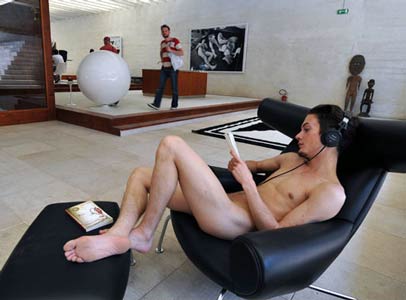
Why?
And why no women? I am a big fan of naturism and nudity in
general, but I don't see the connection here. It would appear
that, as in Modern Dance, gratuitous nudity has been substituted
for art more and more. The human body is more beautiful than
anything these fake artists can come up with, so why not? Also
remember that Birnbaum drove in from Frankfurt, and Germany is
the worldwide leader in public nudity. Germans don't bother to
get dressed to go to the market anymore, much less the museum. If
that is the case, I request some beautiful nude females lounging
about the the museum, reading magazines and drinking coffee and
selling postcards. It might even get me to the show.
The
Golden Lion for best artist in this Biennale went to Tobias
Rehberger, for his decoration in the museum cafe.
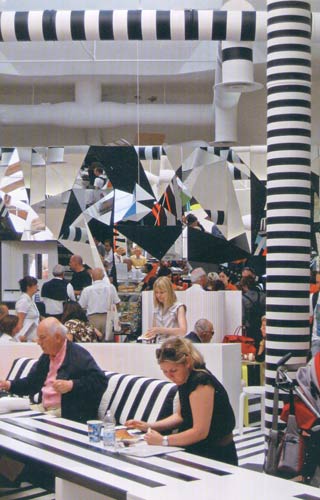
As
you can see, we have some mirrors and stripes. If this is the
most “pleasurable” and “insightful” work in the
exhibition, I suppose we don't need to look at the least.
Rehberger titled this cafeteria, “What you love also
makes you cry.” I don't see how that applies to some stripes on
a pole, but I am struck by the unintended fitness of the title,
applied more broadly. If we apply that title to the show as a
whole, and to the magazine as a whole, and to the last century as
a whole, it takes on some real meaning. Art, a thing I love, has
been turned into this. Art, once the highest expression of human
dexterity, passion, and ambition, is now a sub-collegiate
show-and-tell for well-placed mental defectives, well-dressed
circus barkers, and well-funded state propagandists. It is naught
but a vehicle for the talentless, a highly promoted stage for the
sons and daughters of the elite too stupid to succeed in acting
or pop music. The museum goers and magazine readers and buyers
who look at this stuff are one step stupider, like the sub-morons
who are impressed by the morons of pro-wrestling, or the
super-idiots who are fooled by the idiots of party politics.
As
I understand the need for Walmart greeters, I understand the need
for Modern Art. Just as we need full employment for the least
fortunate, we need full employment for these worthless sons and
daughters of the worldwide wealthy. What I do not understand is
the invisibility of the alternative. We have not replaced the
Olympics with the Special Olympics: we have both. We have seen
Special Art; where is Art? Where are the intelligent and talented
hiding? What ship did I miss? To what cave in Bora Bora have my
peers retired? What uncharted island is sending me a sea of lost
letters?
If
this paper was useful to you in any way, please consider donating
a dollar (or more) to the SAVE THE ARTISTS FOUNDATION. This will
allow me to continue writing these "unpublishable"
things. Don't be confused by paying Melisa Smith--that is just
one of my many noms de plume. If you are a Paypal user,
there is no fee; so it might be worth your while to become one.
Otherwise they will rob us 33 cents for each transaction.
|